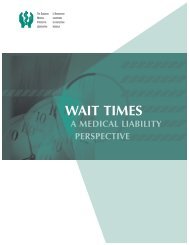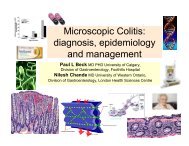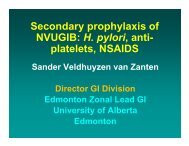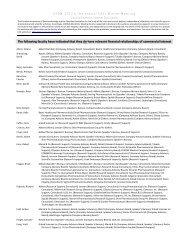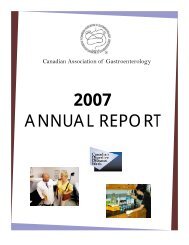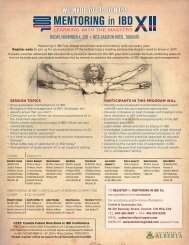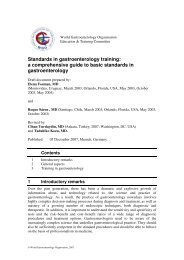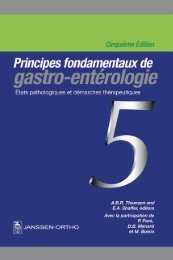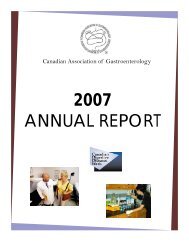Manifestations of Gastrointestinal Disease in the Child
Manifestations of Gastrointestinal Disease in the Child
Manifestations of Gastrointestinal Disease in the Child
Create successful ePaper yourself
Turn your PDF publications into a flip-book with our unique Google optimized e-Paper software.
710 FIRST PRINCIPLES OF GASTROENTEROLOGY<br />
4.7 Management<br />
Management beg<strong>in</strong>s with identify<strong>in</strong>g <strong>the</strong> underly<strong>in</strong>g factors contribut<strong>in</strong>g to<br />
undernutrition and correct<strong>in</strong>g <strong>the</strong>m if possible. In more complex cases it is<br />
very helpful to have a multidiscipl<strong>in</strong>ary approach with physician and nurses,<br />
dietitian, social worker and, if <strong>in</strong>dicated, a behavioral psychologist or feed<strong>in</strong>g<br />
specialist. The goal <strong>of</strong> nutritional management is to promote compensatory<br />
catch-up growth. <strong>Child</strong>ren diagnosed with growth failure secondary to prote<strong>in</strong><br />
calorie malnutrition may need to receive up to 150% <strong>of</strong> <strong>the</strong> recommended<br />
daily caloric <strong>in</strong>take for <strong>the</strong>ir expected, (not actual) weight for age. This is usually<br />
achieved by attempt<strong>in</strong>g to provide nutrient-dense food. For <strong>in</strong>fants, <strong>the</strong> caloric<br />
density <strong>of</strong> formula can be <strong>in</strong>creased and, <strong>in</strong> toddlers, nutrient density is<br />
<strong>in</strong>creased by enrich<strong>in</strong>g preferred food with butter, peanut butter, oil, cheese or<br />
carbohydrate additives. Fruit juice may contribute to poor growth and should<br />
be limited to 240-480 mL/day. Small, frequent feed<strong>in</strong>gs should be <strong>of</strong>fered. In<br />
cases <strong>of</strong> moderate and severe malnutrition, a multivitam<strong>in</strong> supplement should<br />
be <strong>of</strong>fered. Severe malnutrition should be managed <strong>in</strong>-hospital, with close<br />
monitor<strong>in</strong>g <strong>of</strong> electrolytes and fluid balance to prevent refeed<strong>in</strong>g syndrome.<br />
5. ACUTE DIARRHEA IN CHILDREN / J.D. Butzner<br />
5.1 Introduction<br />
A North American child will develop between 6 and 12 episodes <strong>of</strong> acute<br />
diarrhea before <strong>the</strong> age <strong>of</strong> 5. This contributes to approximately 12% <strong>of</strong> childhood<br />
hospitalizations and approximately 300 deaths per year. Worldwide,<br />
acute diarrheal disease is <strong>the</strong> lead<strong>in</strong>g cause <strong>of</strong> childhood morbidity and mortality,<br />
account<strong>in</strong>g for three million deaths each year. Most deaths are caused<br />
by failure to treat acute dehydration properly and to correct electrolyte<br />
imbalances. Studies from both <strong>the</strong> develop<strong>in</strong>g and developed world demonstrate<br />
that hospitalization can be avoided and morbidity and mortality can be<br />
drastically reduced by <strong>the</strong> prompt <strong>in</strong>troduction <strong>of</strong> two simple treatments: oral<br />
rehydration <strong>the</strong>rapy and early refeed<strong>in</strong>g. In spite <strong>of</strong> recommendations to use<br />
oral rehydration <strong>the</strong>rapy and to cont<strong>in</strong>ue or resume feed<strong>in</strong>g early <strong>in</strong> mild<br />
to moderate diarrheal illnesses, <strong>the</strong> use <strong>of</strong> unsuitable treatments persists.<br />
These <strong>in</strong>clude unnecessary <strong>in</strong>travenous <strong>the</strong>rapy, <strong>in</strong>appropriate oral fluids<br />
(unbalanced sugar-electrolyte solutions), prolonged starvation with a slow<br />
<strong>in</strong>troduction <strong>of</strong> limited feeds, and <strong>the</strong> <strong>in</strong>appropriate use <strong>of</strong> antibiotics as<br />
well as antimotility and antidiarrheal agents.<br />
5.2 Pathophysiology <strong>of</strong> Acute Diarrheal <strong>Disease</strong><br />
An understand<strong>in</strong>g <strong>of</strong> <strong>the</strong> physiology <strong>of</strong> <strong>in</strong>test<strong>in</strong>al fluid, electrolyte and nutrient<br />
transport provides a basis for understand<strong>in</strong>g <strong>the</strong> mechanisms <strong>of</strong> acute diarrheal<br />
disease and successful oral rehydration <strong>the</strong>rapy. Water absorption occurs




